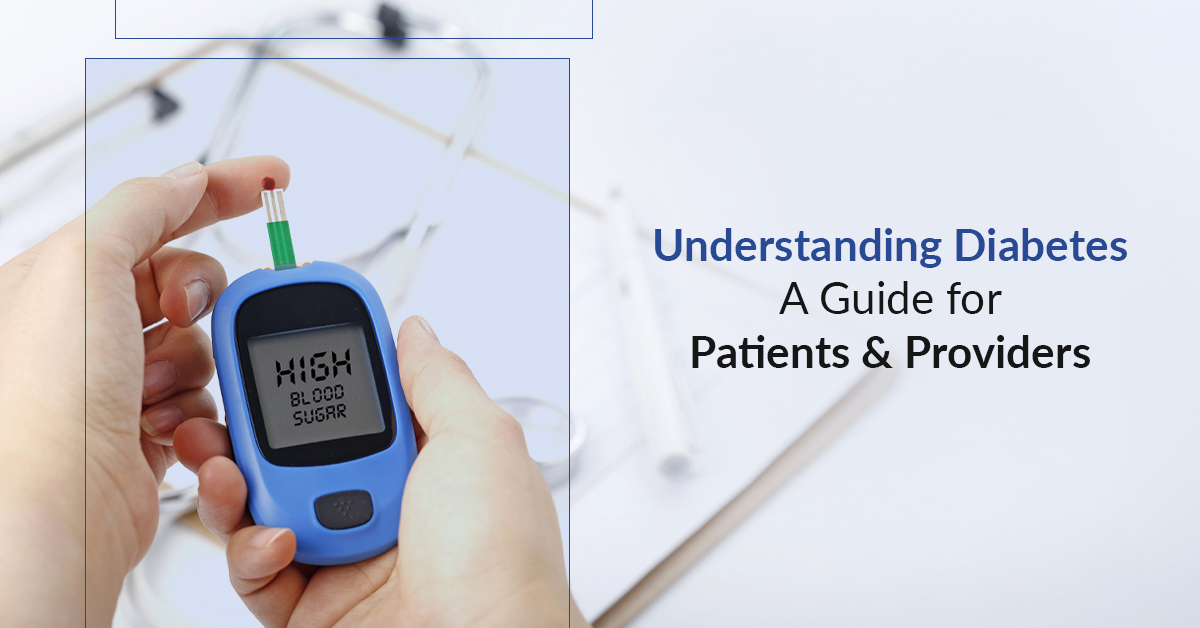Understanding Diabetes: A Comprehensive Guide for Patients and Healthcare Providers
Introduction
Diabetes is a chronic metabolic disorder characterized by elevated blood glucose levels. It affects millions of
people worldwide and presents a significant challenge to global health systems. This comprehensive guide aims to
provide patients and healthcare providers with an in-depth understanding of diabetes, including diabetes
symptoms, types, causes, management strategies, and recent advancements in treatment. By exploring these
aspects, we can enhance awareness, improve patient care, and promote better health outcomes.
Types of Diabetes
- Type 1 Diabetes
- Definition and Causes: Type 1 diabetes is an autoimmune condition in which the immune
system attacks insulin-producing beta cells in the pancreas. The exact cause is unknown but may involve
genetic and environmental factors.
- Symptoms: Common symptoms include frequent urination, excessive thirst, weight loss,
fatigue, and blurred vision.
- Management: Requires lifelong insulin therapy, blood glucose monitoring, and a
diabetic diet.
- Type 2 Diabetes
- Definition and Causes: Characterized by insulin resistance, type 2 diabetes is often
linked to obesity, a sedentary lifestyle, and genetic predisposition.
- Symptoms:Includes increased thirst, frequent urination, fatigue, blurred vision, and
slow-healing wounds.
- Management: Involves lifestyle changes, a balanced diabetic diet chart, oral
medications, and sometimes insulin. Type 2 diabetes treatment may also include injectable
medications.
- Gestational Diabetes
- Definition and Causes: Develops during pregnancy due to hormonal changes and insulin
resistance.
- Symptoms: Often asymptomatic but may cause increased thirst and urination.
- Management: Managed with a healthy diabetic diet, exercise, and blood glucose
monitoring. Women with gestational diabetes have a higher risk of developing type 2 diabetes
later.
- Other Specific Types
- Diabetes Insipidus: A rare condition characterized by excessive thirst and urination
but unrelated to blood glucose levels.
- Monogenic Diabetes: Caused by single gene mutations, including MODY.
- Secondary Diabetes:Resulting from other conditions or medications.
Causes and Risk Factors
- Genetic Factors:
- Family History: Increases risk.
- Ethnic Background: Higher risk among certain populations.
- Lifestyle Factors:
- Obesity: A major risk factor.
- Diet: High in sugars and unhealthy fats increases risk. Fruits for diabetic
patients like berries and apples can help manage blood sugar.
- Sedentary Lifestyle: Reduces insulin sensitivity.
- Environmental Factors:
- Toxins and Stress: May influence diabetes risk.
Symptoms and Diagnosis
Common Symptoms:
- Increased Thirst and Urination
- Fatigue
- Blurred Vision
- Slow-Healing Wounds
Diagnostic Tests:
- Fasting Plasma Glucose (FPG)
- Oral Glucose Tolerance Test (OGTT)
- Hemoglobin A1c (HbA1c)
- Random Plasma Glucose Test
Complications of Diabetes
- Diabetic Retinopathy:
- Damage to the blood vessels in the eyes. Regular eye exams are essential.
- Diabetic Neuropathy:
- Nerve damage causing pain and numbness, especially in the feet.
- Diabetic Foot Ulcer:
- Open sores that may lead to severe infections if untreated.
Management and Treatment
- Lifestyle Modifications:
- Diet: A balanced diet with controlled portions and low-glycemic foods.
- Exercise: Helps in weight management and improves insulin sensitivity.
- Weight Management: Essential for managing type 2 diabetes.
- Medications:
- Oral Medications: Include metformin and sulfonylureas.
- Insulin Therapy:Essential for type 1 diabetes treatment and sometimes for
type 2 diabetes treatment.
- Injectable Medications: Include GLP-1 receptor agonists.
- Diabetes Tablets: Often prescribed to control blood sugar.
- Monitoring and Self-Care:
- Blood Glucose Monitoring: Regular checks help manage diabetes effectively.
- Foot Care: Essential to prevent diabetic foot ulcers.
- Regular Check-Ups:For eyes, kidneys, and blood pressure.
Recent Advances in Diabetes Research
- Continuous Glucose Monitoring (CGM):
- Provides real-time glucose levels, reducing the need for fingerstick tests.
- Artificial Pancreas Systems:
- Combines insulin pumps with CGM for automated insulin delivery.
- New Medications:
- Emerging drugs target specific pathways to manage blood glucose more effectively.
- Best medicine for diabetes: Continues to evolve with research.
- Personalized Medicine:
- Tailors treatment based on individual genetic profiles.
How to Prevent Diabetes
- Healthy Diet: Focus on whole grains, lean proteins, and fruits for diabetic patients.
- Regular Exercise: : At least 30 minutes a day.
- Weight Management: Reduces the risk of type 2 diabetes.
- Stress Management:Helps maintain stable blood glucose levels.
Conclusion
Diabetes is a complex condition that requires a comprehensive management approach. Understanding what causes
diabetes, its symptoms, and treatment options is crucial for patients and healthcare providers alike. With
advances
in medications, technologies, and personalized care, managing diabetes effectively has become more achievable. A
proactive approach, including lifestyle changes, medication adherence, and regular monitoring, can help prevent
complications and improve quality of life for those with diabetes.
Healthcare providers play a vital role in guiding patients through this journey with personalized care and support.
Continued research and innovation promise to enhance diabetes management and offer hope for a healthier future.
